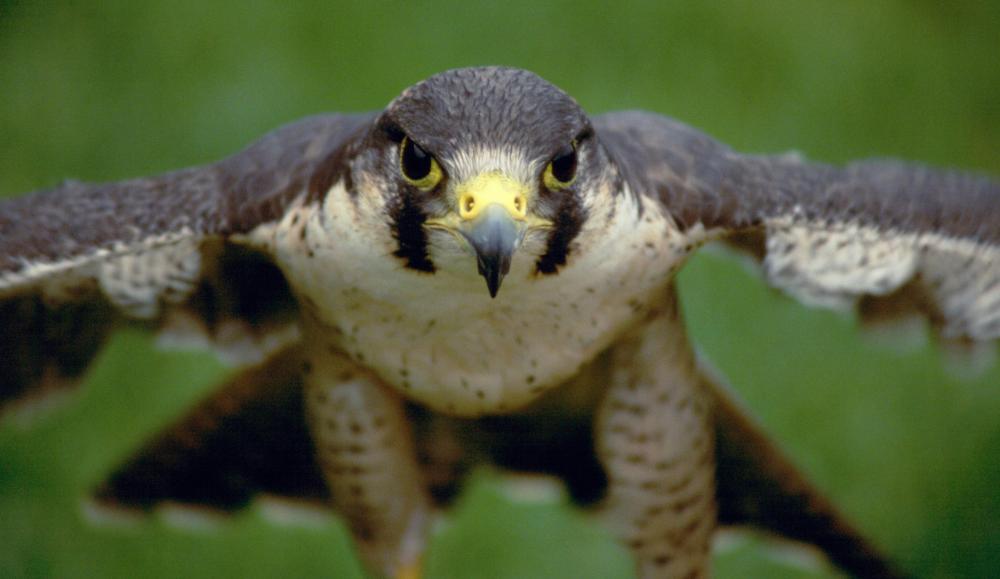At AllThingsNature, we're committed to delivering accurate, trustworthy information. Our expert-authored content is rigorously fact-checked and sourced from credible authorities. Discover how we uphold the highest standards in providing you with reliable knowledge.
What is a Prairie Falcon?
A prairie falcon is a North American bird that relishes the open country of prairies, deserts, and alpine landscapes. A member of the falcon family, the prairie falcon is often used as a trained hunter in the ancient sport of falconry. Prairie falcons are believed to have a relatively stable population throughout much of their native range; however, encroachment has lead to some reduction in breeding sites, food supply, and habitat.
An adult prairie falcon looks quite similar to its near relative, the peregrine falcon, but can be distinguished through coloration. Prairie falcons have mottled gray-brown feathers on their backs and tails, with a white chest marked with brown spots or streaks. Under the wing, the prairie bird features a dark colored patch that makes it easily distinguishable from the peregrine when in flight.

A mighty aerial hunter, this falcon searches for prey flying low to the ground, preferring to use the element of surprise to swoop down unexpectedly and snatch away a meal. Generally, the diet consists of small mammals or the young of medium sized mammals, including squirrels, prairie dogs, and mice. Falcons also eat other birds, generally catching them in flight. In some cases, a falcon may also dine on insects and reptiles.

The natural habitat of the species is enormous, stretching throughout most of the North American continent. Birds are found throughout a large portion of the western and central United States and lower sections of Canada. Some even range as far south as central Mexico, despite the vast climate change from the temperate plains and chilly north.
Although the birds tend to hunt on open grassland, they prefer to nest in rocky cliffs, which offer protection from some predators. Falcons may share cliff space amicably with a variety of other raptor species, including eagles and hawks. Fledgling falcons are helpless at birth, and remain in the nest for five or six weeks. The birds remain in monogamous pairs throughout the breeding season, with the male prairie falcon taking on hunting duties for the fledglings during the first few weeks after hatching.
Thanks to a large population and easy availability, the prairie falcon has been a favorite bird for use in hunting, called falconry. Training and hunting with falcons has long been an extracurricular activity at the United States Air Force Academy since the 1950s, with many prairie falcons used in the program. The particular species is often admired for its versatile hunting tactics and aggressive attack style.
Frequently Asked Questions
What is a Prairie Falcon?
The Prairie Falcon is a medium-sized bird of prey belonging to the falcon family. It is known for its impressive speed and agility in flight, often seen hunting in open landscapes like grasslands and deserts across western North America. With a wingspan of about 90-110 cm, it's a formidable hunter, preying on small mammals and birds.
Where can you typically find Prairie Falcons?
Prairie Falcons are commonly found in the arid and semi-arid regions of western North America, from southern Canada to northern Mexico. They prefer open habitats such as prairies, deserts, and plateaus where they can easily spot and dive for prey at high speeds.
What does the Prairie Falcon eat?
Prairie Falcons have a diverse diet that primarily includes small mammals like ground squirrels and rodents, as well as birds such as doves and pheasants. They are skilled hunters, often capturing their prey in mid-air after a swift, powerful dive known as a stoop.
How do Prairie Falcons nest and raise their young?
Prairie Falcons do not build traditional nests; instead, they lay their eggs in scrapes on cliff ledges, in crevices, or sometimes in old nests of other birds. The female typically lays 3-5 eggs and incubates them for about a month, while the male provides food. Both parents care for the young after hatching.
Are Prairie Falcons endangered?
As of my knowledge cutoff in 2023, Prairie Falcons are not considered endangered. They are classified as 'Least Concern' by the IUCN Red List, indicating a stable population. However, they face threats from habitat loss and pesticide exposure, which require ongoing conservation efforts to ensure their populations remain healthy.
How do Prairie Falcons differ from other falcons?
Prairie Falcons are distinguished from other falcons by their unique plumage, behavior, and habitat preferences. They have a creamy underbelly with dark brown spots, a dark "mustache" mark on their face, and prefer open habitats. Unlike Peregrine Falcons, they are more adapted to hunting in terrestrial environments rather than near water bodies.
AS FEATURED ON:
AS FEATURED ON:












Discuss this Article
Post your comments